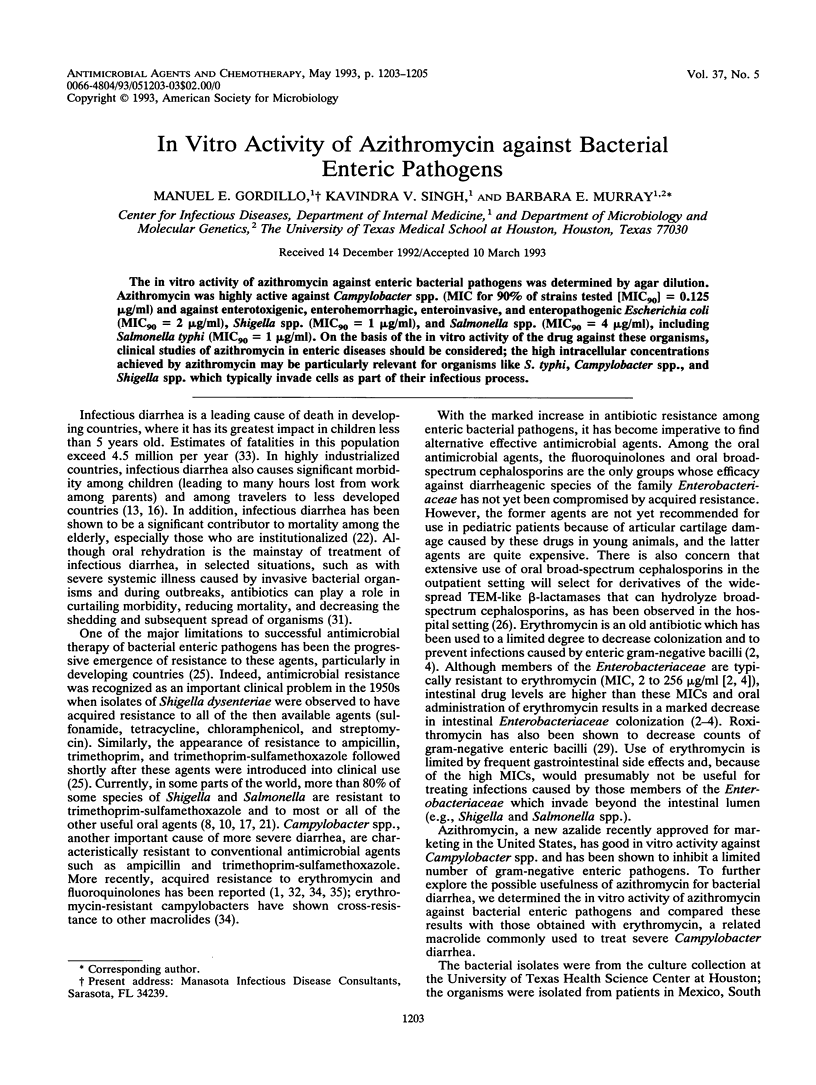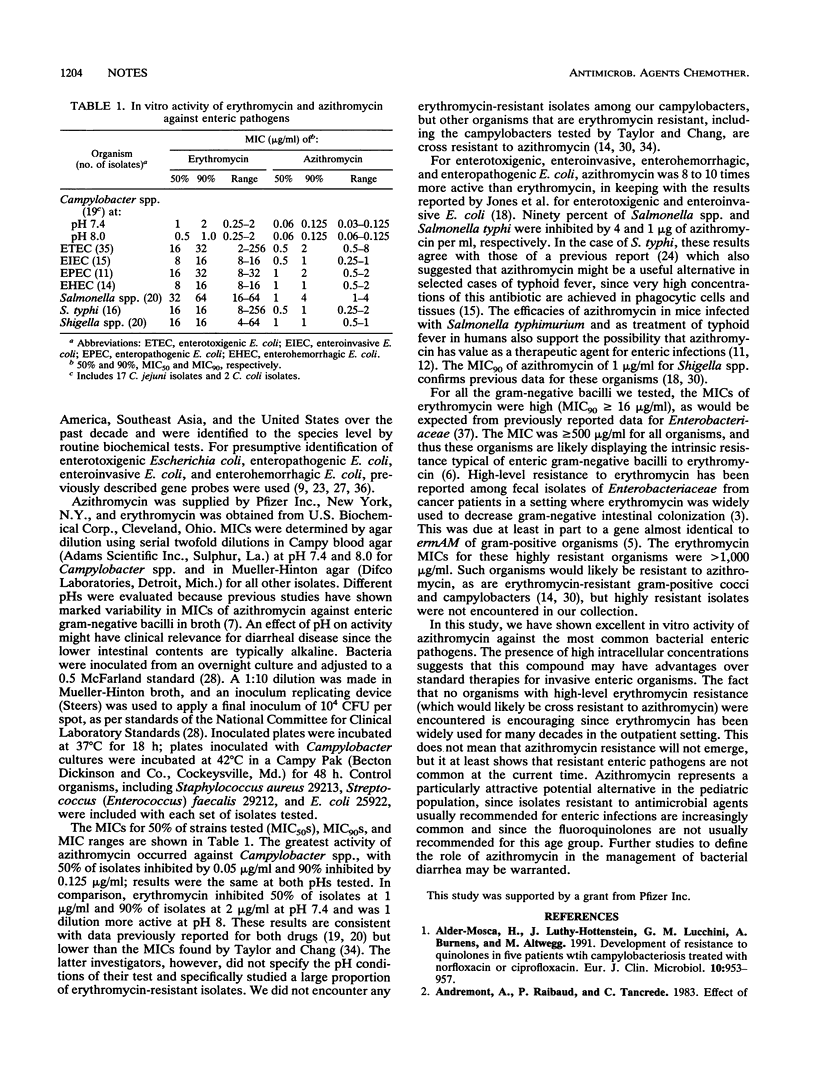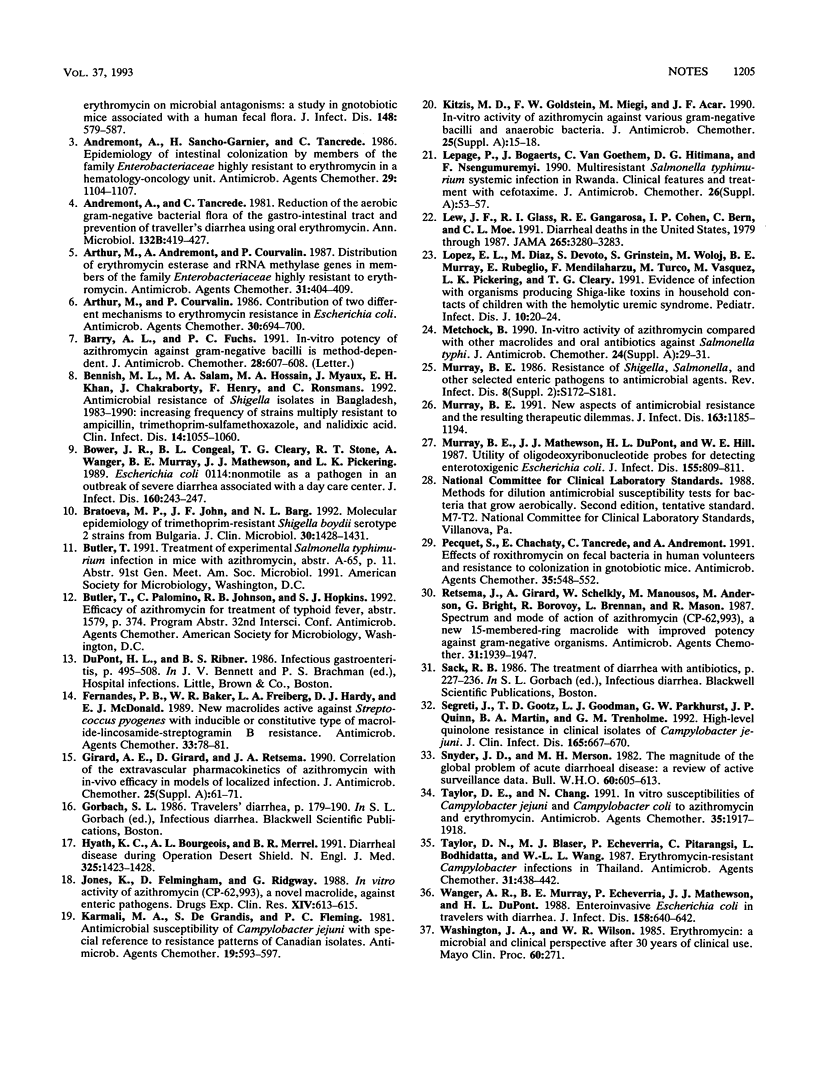Abstract
The in vitro activity of azithromycin against enteric bacterial pathogens was determined by agar dilution. Azithromycin was highly active against Campylobacter spp. (MIC for 90% of strains tested [MIC90] = 0.125 micrograms/ml) and against enterotoxigenic, enterohemorrhagic, enteroinvasive, and enteropathogenic Escherichia coli (MIC90 = 2 micrograms/ml), Shigella spp. (MIC90 = 1 micrograms/ml), and Salmonella spp. (MIC90 = 4 micrograms/ml), including Salmonella typhi (MIC90 = 1 microgram/ml). On the basis of the in vitro activity of the drug against these organisms, clinical studies of azithromycin in enteric diseases should be considered; the high intracellular concentrations achieved by azithromycin may be particularly relevant for organisms like S. typhi, Campylobacter spp., and Shigella spp. which typically invade cells as part of their infectious process.
Full text
PDF


Selected References
These references are in PubMed. This may not be the complete list of references from this article.
- Adler-Mosca H., Lüthy-Hottenstein J., Martinetti Lucchini G., Burnens A., Altwegg M. Development of resistance to quinolones in five patients with campylobacteriosis treated with norfloxacin or ciprofloxacin. Eur J Clin Microbiol Infect Dis. 1991 Nov;10(11):953–957. doi: 10.1007/BF02005451. [DOI] [PubMed] [Google Scholar]
- Andremont A., Raibaud P., Tancrède C. Effect of erythromycin on microbial antagonisms: a study in gnotobiotic mice associated with a human fecal flora. J Infect Dis. 1983 Sep;148(3):579–587. doi: 10.1093/infdis/148.3.579. [DOI] [PubMed] [Google Scholar]
- Andremont A., Sancho-Garnier H., Tancrede C. Epidemiology of intestinal colonization by members of the family Enterobacteriaceae highly resistant to erythromycin in a hematology-oncology unit. Antimicrob Agents Chemother. 1986 Jun;29(6):1104–1107. doi: 10.1128/aac.29.6.1104. [DOI] [PMC free article] [PubMed] [Google Scholar]
- Andremont A., Tancrede C. Reduction of the aerobic Gram negative bacterial flora of the gastro-intestinal tract and prevention of traveller's diarrhea using oral erythromycin. Ann Microbiol (Paris) 1981 Nov-Dec;132 B(3):419–427. [PubMed] [Google Scholar]
- Arthur M., Andremont A., Courvalin P. Distribution of erythromycin esterase and rRNA methylase genes in members of the family Enterobacteriaceae highly resistant to erythromycin. Antimicrob Agents Chemother. 1987 Mar;31(3):404–409. doi: 10.1128/aac.31.3.404. [DOI] [PMC free article] [PubMed] [Google Scholar]
- Arthur M., Courvalin P. Contribution of two different mechanisms to erythromycin resistance in Escherichia coli. Antimicrob Agents Chemother. 1986 Nov;30(5):694–700. doi: 10.1128/aac.30.5.694. [DOI] [PMC free article] [PubMed] [Google Scholar]
- Barry A. L., Fuchs P. C. In-vitro potency of azithromycin against gram-negative bacilli is method-dependent. J Antimicrob Chemother. 1991 Oct;28(4):607–610. doi: 10.1093/jac/28.4.607. [DOI] [PubMed] [Google Scholar]
- Bennish M. L., Salam M. A., Hossain M. A., Myaux J., Khan E. H., Chakraborty J., Henry F., Ronsmans C. Antimicrobial resistance of Shigella isolates in Bangladesh, 1983-1990: increasing frequency of strains multiply resistant to ampicillin, trimethoprim-sulfamethoxazole, and nalidixic acid. Clin Infect Dis. 1992 May;14(5):1055–1060. doi: 10.1093/clinids/14.5.1055. [DOI] [PubMed] [Google Scholar]
- Bower J. R., Congeni B. L., Cleary T. G., Stone R. T., Wanger A., Murray B. E., Mathewson J. J., Pickering L. K. Escherichia coli O114:nonmotile as a pathogen in an outbreak of severe diarrhea associated with a day care center. J Infect Dis. 1989 Aug;160(2):243–247. doi: 10.1093/infdis/160.2.243. [DOI] [PubMed] [Google Scholar]
- Bratoeva M. P., John J. F., Barg N. L. Molecular epidemiology of trimethoprim-resistant Shigella boydii serotype 2 strains from Bulgaria. J Clin Microbiol. 1992 Jun;30(6):1428–1431. doi: 10.1128/jcm.30.6.1428-1431.1992. [DOI] [PMC free article] [PubMed] [Google Scholar]
- Fernandes P. B., Baker W. R., Freiberg L. A., Hardy D. J., McDonald E. J. New macrolides active against Streptococcus pyogenes with inducible or constitutive type of macrolide-lincosamide-streptogramin B resistance. Antimicrob Agents Chemother. 1989 Jan;33(1):78–81. doi: 10.1128/aac.33.1.78. [DOI] [PMC free article] [PubMed] [Google Scholar]
- Girard A. E., Girard D., Retsema J. A. Correlation of the extravascular pharmacokinetics of azithromycin with in-vivo efficacy in models of localized infection. J Antimicrob Chemother. 1990 Jan;25 (Suppl A):61–71. doi: 10.1093/jac/25.suppl_a.61. [DOI] [PubMed] [Google Scholar]
- Hyams K. C., Bourgeois A. L., Merrell B. R., Rozmajzl P., Escamilla J., Thornton S. A., Wasserman G. M., Burke A., Echeverria P., Green K. Y. Diarrheal disease during Operation Desert Shield. N Engl J Med. 1991 Nov 14;325(20):1423–1428. doi: 10.1056/NEJM199111143252006. [DOI] [PubMed] [Google Scholar]
- Jones K., Felmingham D., Ridgway G. In vitro activity of azithromycin (CP-62,993), a novel macrolide, against enteric pathogens. Drugs Exp Clin Res. 1988;14(10):613–615. [PubMed] [Google Scholar]
- Karmali M. A., De Grandis S., Fleming P. C. Antimicrobial susceptibility of Campylobacter jejuni with special reference to resistance patterns of Canadian isolates. Antimicrob Agents Chemother. 1981 Apr;19(4):593–597. doi: 10.1128/aac.19.4.593. [DOI] [PMC free article] [PubMed] [Google Scholar]
- Kitzis M. D., Goldstein F. W., Miégi M., Acar J. F. In-vitro activity of azithromycin against various Gram-negative bacilli and anaerobic bacteria. J Antimicrob Chemother. 1990 Jan;25 (Suppl A):15–18. doi: 10.1093/jac/25.suppl_a.15. [DOI] [PubMed] [Google Scholar]
- Lepage P., Bogaerts J., Van Goethem C., Hitimana D. G., Nsengumuremyi F. Multiresistant Salmonella typhimurium systemic infection in Rwanda. Clinical features and treatment with cefotaxime. J Antimicrob Chemother. 1990 Sep;26 (Suppl A):53–57. doi: 10.1093/jac/26.suppl_a.53. [DOI] [PubMed] [Google Scholar]
- Lew J. F., Glass R. I., Gangarosa R. E., Cohen I. P., Bern C., Moe C. L. Diarrheal deaths in the United States, 1979 through 1987. A special problem for the elderly. JAMA. 1991 Jun 26;265(24):3280–3284. [PubMed] [Google Scholar]
- Lopez E. L., Diaz M., Devoto S., Grinstein S., Woloj M., Murray B. E., Rubeglio E., Mendilaharzu F., Turco M., Vasquez M. Evidence of infection with organisms producing Shiga-like toxins in household contacts of children with the hemolytic uremic syndrome. Pediatr Infect Dis J. 1991 Jan;10(1):20–24. doi: 10.1097/00006454-199101000-00005. [DOI] [PubMed] [Google Scholar]
- Metchock B. In-vitro activity of azithromycin compared with other macrolides and oral antibiotics against Salmonella typhi. J Antimicrob Chemother. 1990 Jan;25 (Suppl A):29–31. doi: 10.1093/jac/25.suppl_a.29. [DOI] [PubMed] [Google Scholar]
- Murray B. E., Mathewson J. J., DuPont H. L., Hill W. E. Utility of oligodeoxyribonucleotide probes for detecting enterotoxigenic Escherichia coli. J Infect Dis. 1987 Apr;155(4):809–811. doi: 10.1093/infdis/155.4.809. [DOI] [PubMed] [Google Scholar]
- Murray B. E. New aspects of antimicrobial resistance and the resulting therapeutic dilemmas. J Infect Dis. 1991 Jun;163(6):1184–1194. [PubMed] [Google Scholar]
- Murray B. E. Resistance of Shigella, Salmonella, and other selected enteric pathogens to antimicrobial agents. Rev Infect Dis. 1986 May-Jun;8 (Suppl 2):S172–S181. doi: 10.1093/clinids/8.supplement_2.s172. [DOI] [PubMed] [Google Scholar]
- Pecquet S., Chachaty E., Tancrède C., Andremont A. Effects of roxithromycin on fecal bacteria in human volunteers and resistance to colonization in gnotobiotic mice. Antimicrob Agents Chemother. 1991 Mar;35(3):548–552. doi: 10.1128/aac.35.3.548. [DOI] [PMC free article] [PubMed] [Google Scholar]
- Retsema J., Girard A., Schelkly W., Manousos M., Anderson M., Bright G., Borovoy R., Brennan L., Mason R. Spectrum and mode of action of azithromycin (CP-62,993), a new 15-membered-ring macrolide with improved potency against gram-negative organisms. Antimicrob Agents Chemother. 1987 Dec;31(12):1939–1947. doi: 10.1128/aac.31.12.1939. [DOI] [PMC free article] [PubMed] [Google Scholar]
- Segreti J., Gootz T. D., Goodman L. J., Parkhurst G. W., Quinn J. P., Martin B. A., Trenholme G. M. High-level quinolone resistance in clinical isolates of Campylobacter jejuni. J Infect Dis. 1992 Apr;165(4):667–670. doi: 10.1093/infdis/165.4.667. [DOI] [PubMed] [Google Scholar]
- Snyder J. D., Merson M. H. The magnitude of the global problem of acute diarrhoeal disease: a review of active surveillance data. Bull World Health Organ. 1982;60(4):605–613. [PMC free article] [PubMed] [Google Scholar]
- Taylor D. E., Chang N. In vitro susceptibilities of Campylobacter jejuni and Campylobacter coli to azithromycin and erythromycin. Antimicrob Agents Chemother. 1991 Sep;35(9):1917–1918. doi: 10.1128/aac.35.9.1917. [DOI] [PMC free article] [PubMed] [Google Scholar]
- Taylor D. N., Blaser M. J., Echeverria P., Pitarangsi C., Bodhidatta L., Wang W. L. Erythromycin-resistant Campylobacter infections in Thailand. Antimicrob Agents Chemother. 1987 Mar;31(3):438–442. doi: 10.1128/aac.31.3.438. [DOI] [PMC free article] [PubMed] [Google Scholar]
- Wanger A. R., Murray B. E., Echeverria P., Mathewson J. J., DuPont H. L. Enteroinvasive Escherichia coli in travelers with diarrhea. J Infect Dis. 1988 Sep;158(3):640–642. doi: 10.1093/infdis/158.3.640. [DOI] [PubMed] [Google Scholar]
- Washington J. A., 2nd, Wilson W. R. Erythromycin: a microbial and clinical perspective after 30 years of clinical use (2). Mayo Clin Proc. 1985 Apr;60(4):271–278. doi: 10.1016/s0025-6196(12)60322-x. [DOI] [PubMed] [Google Scholar]


